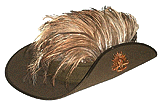kangaroo- n. a large Australian marsupial with a long powerful tail and strong hind legs that enable it to travel by leaping. (Pocket Oxford English Dictionary 9th ed).
Although as a child I lived on a property where it wasn’t uncommon to see the odd kangaroo in the garden, kangaroos do not bounce and leap down the streets of King’s Cross nor do we ride them to school or work. Australia is also one of the only nations in the world that eats its own national emblem (tastes sort of spicy). Yet the one thing that is very clear and blindingly obvious is that kangaroos do NOT have feathers.
So why the title to my first book in the Hopscotch Chronicles?
In 1915, at the beginning of World War One, both Australian and New Zealand troops fought against the Turks at Gallipoli. These ANZACS, or Australian and New Zealand Army Corps, were uniformed in khaki often with a metal or felt wide brimmed hat. The Australian Imperial Force (AIF) light horsemen wore a slightly different uniform compared to their fellow diggers with the main difference being the Australian slouch hat adorned with the emu feather plume.
emu-n. a flightless Australian bird similar to an osterich. (Pocket Oxford English Dictionary 9th ed).
This plume was clearly recognisable and soon became a legend in itself, becoming a symbol for the light horsemen and the awe and wonder these men inspired. Yet like aussies today, the AIF light horsemen loved a good practical joke and when asked about their plumes would reply that they were in all actuality “kangaroo feathers.” This joke soon took its place amongst tales of the bunyip and drop bear and continues to this day to confuse aliens.

